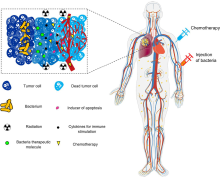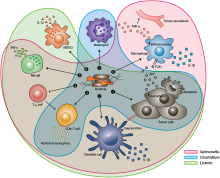Tumor-homing bacteria
Appearance
This article may be in need of reorganization to comply with Wikipedia's layout guidelines. (April 2020) |



Tumor-homing bacteria are ones that thrive in hypoxic environments (such as hypoxic tumors), which upon entering into the bloodstream, tend to migrate to, invade (through the leaky vasculature in the tumor microenvironment) and colonize tumors. This property tends to increase their residence time in the tumor, giving them longer to exert their therapeutic effects, in contrast to other bacteria that would be quickly cleared by the immune system.[1][2][3] There is tremendous interest in using tumor-homing bacteria as living medicines to treat cancer.[4][5][6][7]
References
- ^ Duong, Mai Thi-Quynh; Qin, Yeshan; You, Sung-Hwan; Min, Jung-Joon (2019-12-11). "Bacteria-cancer interactions: bacteria-based cancer therapy". Experimental & Molecular Medicine. 51 (12): 1–15. doi:10.1038/s12276-019-0297-0. ISSN 2092-6413. PMC 6906302. PMID 31827064.
- ^ Sedighi, Mansour; Zahedi Bialvaei, Abed; Hamblin, Michael R.; Ohadi, Elnaz; Asadi, Arezoo; Halajzadeh, Masoumeh; Lohrasbi, Vahid; Mohammadzadeh, Nima; Amiriani, Taghi; Krutova, Marcela; Amini, Abolfazl (2019-04-05). "Therapeutic bacteria to combat cancer; current advances, challenges, and opportunities". Cancer Medicine. 8 (6): 3167–3181. doi:10.1002/cam4.2148. ISSN 2045-7634. PMC 6558487. PMID 30950210.
- ^ Song, Shiyu; Vuai, Miza S.; Zhong, Mintao (2018-03-15). "The role of bacteria in cancer therapy – enemies in the past, but allies at present". Infectious Agents and Cancer. 13 (1): 9. doi:10.1186/s13027-018-0180-y. ISSN 1750-9378. PMC 5856380. PMID 29568324.
{{cite journal}}: CS1 maint: unflagged free DOI (link) - ^ Liu, Guanshu; Bettegowda, Chetan; Qiao, Yuan; Staedtke, Verena; Chan, Kannie W.Y.; Bai, Renyuan; Li, Yuguo; Riggins, Gregory J.; Kinzler, Kenneth W.; Bulte, Jeff W.M.; McMahon, Michael T. (2013-10-07). "Noninvasive imaging of infection after treatment with tumor-homing bacteria using Chemical Exchange Saturation Transfer (CEST) MRI: CEST MRI of Bacteria". Magnetic Resonance in Medicine. 70 (6): 1690–1698. doi:10.1002/mrm.24955. PMC 3857583. PMID 24123389.
- ^ Chien, Tiffany; Doshi, Anjali; Danino, Tal (2017-05-23). "Advances in bacterial cancer therapies using synthetic biology". Current Opinion in Systems Biology. 5: 1–8. doi:10.1016/j.coisb.2017.05.009. PMC 5986102. PMID 29881788.
- ^ "Cancer-fighting bacteria". MIT News. Retrieved 2020-04-08.
- ^ "Diagnosing cancer with help from bacteria". MIT News. Retrieved 2020-04-08.
